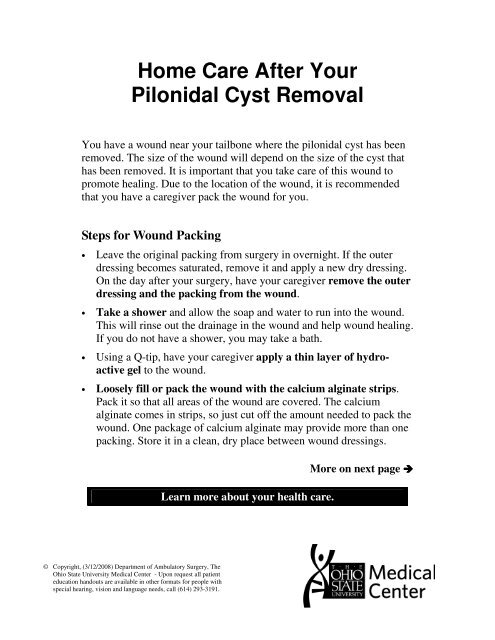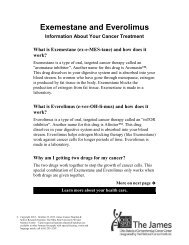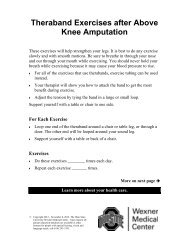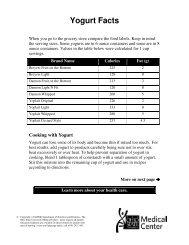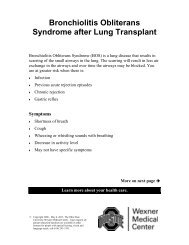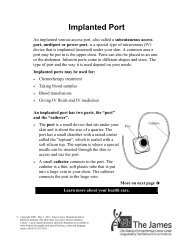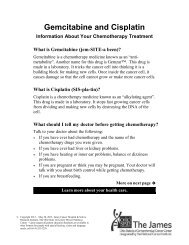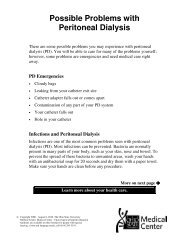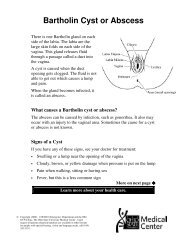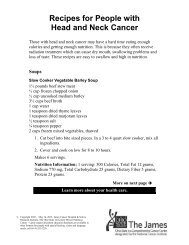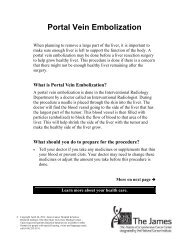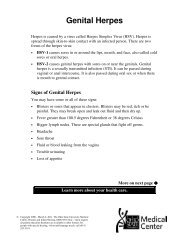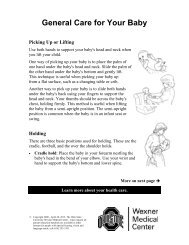Home Care After Your Pilonidal Cyst Removal - Patient Education ...
Home Care After Your Pilonidal Cyst Removal - Patient Education ...
Home Care After Your Pilonidal Cyst Removal - Patient Education ...
Create successful ePaper yourself
Turn your PDF publications into a flip-book with our unique Google optimized e-Paper software.
<strong>Home</strong> <strong>Care</strong> <strong>After</strong> <strong>Your</strong><br />
<strong>Pilonidal</strong> <strong>Cyst</strong> <strong>Removal</strong><br />
You have a wound near your tailbone where the pilonidal cyst has been<br />
removed. The size of the wound will depend on the size of the cyst that<br />
has been removed. It is important that you take care of this wound to<br />
promote healing. Due to the location of the wound, it is recommended<br />
that you have a caregiver pack the wound for you.<br />
Steps for Wound Packing<br />
• Leave the original packing from surgery in overnight. If the outer<br />
dressing becomes saturated, remove it and apply a new dry dressing.<br />
On the day after your surgery, have your caregiver remove the outer<br />
dressing and the packing from the wound.<br />
• Take a shower and allow the soap and water to run into the wound.<br />
This will rinse out the drainage in the wound and help wound healing.<br />
If you do not have a shower, you may take a bath.<br />
• Using a Q-tip, have your caregiver apply a thin layer of hydroactive<br />
gel to the wound.<br />
• Loosely fill or pack the wound with the calcium alginate strips.<br />
Pack it so that all areas of the wound are covered. The calcium<br />
alginate comes in strips, so just cut off the amount needed to pack the<br />
wound. One package of calcium alginate may provide more than one<br />
packing. Store it in a clean, dry place between wound dressings.<br />
© Copyright, (3/12/2008) Department of Ambulatory Surgery, The<br />
Ohio State University Medical Center - Upon request all patient<br />
education handouts are available in other formats for people with<br />
special hearing, vision and language needs, call (614) 293-3191.<br />
Learn more about your health care.<br />
More on next page
Page 2<br />
• Cover the wound with an absorbent dressing and tape in place.<br />
• This is considered a clean procedure. <strong>Your</strong> caregiver can wear nonsterile<br />
medical gloves while packing your wound.<br />
Frequency of Wound <strong>Care</strong><br />
At first, the wound should be cleaned and packed twice a day. As the<br />
calcium alginate dressing becomes saturated with drainage from the<br />
wound, it will change into a gel. The drainage should decrease after a<br />
few days, and the wound can be changed one time each day.<br />
Drainage<br />
• You may notice that the drainage from the wound is thick and has an<br />
odor. These problems can be controlled by showering. You may need<br />
to pack the wound 3 times a day if the drainage saturates the outer<br />
dressing. As the drainage slows down, you can decrease the<br />
frequency of the dressing changes.<br />
• A small amount of blood may be seen on the packing. This may<br />
occur even if the wound bed is dry. Apply the hydro-active wound<br />
gel to keep the wound moist and continue to pack the wound with the<br />
calcium alginate.<br />
Discomfort<br />
You may have pain for 4 to 5 days after your surgery. You will be given<br />
a prescription for pain medicine before you leave the hospital. As your<br />
pain eases, you can take Tylenol or Ibuprofen for discomfort if your<br />
doctor approves.<br />
Healing<br />
• The healing time of your wound will depend on its initial size. It may<br />
take 4 to 6 weeks for the wound to heal.
Page 3<br />
• <strong>Your</strong> caregiver may not notice any change for the first week after<br />
your surgery, then the wound bed should appear beefy red and should<br />
slowly decrease in size.<br />
• The wound should be packed until it has healed or your doctor tells<br />
you to stop the packing. Keep your wound clean and follow the<br />
wound care instructions to promote wound healing.<br />
Activities<br />
You may resume your normal activities as you feel well enough. You<br />
should not drive while you are taking pain medicine that may cause<br />
sleepiness.<br />
When to Call <strong>Your</strong> Doctor<br />
Please call:<br />
• If you have a temperature of 101 degrees or higher.<br />
• If you have any questions or concerns.<br />
• For a return appointment 2 to 3 weeks after your surgery.<br />
• During weekday hours of 8 AM to 4:30 PM, call (614) 293-8133.<br />
• <strong>After</strong> hours and / or weekends, call the hospital operator at (614)<br />
293-8000 and ask for the surgical resident on call.<br />
■ Talk to your doctor or others on your health care team if you<br />
have questions. You may request more written information from<br />
the Library for Health Information at (614) 293-3707 or email:<br />
health-info@osu.edu.


